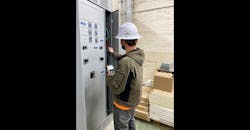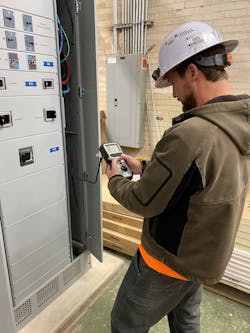Sometimes trying to measure electrical wires and cables in an old building is like trying to find a needle in a haystack, considering that they may be buried beneath a concrete floor or run through other inaccessible places. These jobs can become complex (not to mention very costly), especially if the person looking for the cables/wires doesn’t have the right tools to perform the job. That is exactly what happened when Freedom ElecTech, a full-service electrical and system-integration contractor serving Northwest North Carolina, was awarded a contract to remodel a local high school.
No work can begin until several studies are performed.
The firm was awarded a contract for the remodeling job — a 55,000-sq-ft addition was being added to the school. “We were tasked with installing a new electrical service to the addition, along with redoing the two existing services in the older portion of the school,” said Seth Caviness, president and part-owner of Freedom ElecTech. “Adding new service and integrating wiring from a part of the old building that would remain standing into the new building came with some challenges. In the state of North Carolina, depending on the job and certain criteria, an arc flash study, short circuit study, and coordination study are required to be performed by an electrical engineer.”
Arc flash study
An arc flash study is the assessment of a facility by an electrical professional to determine risks and hazards in relation to electrical systems. All equipment operating at 50V and higher must be assessed for electric shock and potential arc flash hazards per OSHA regulations and NFPA 70E, Standard for Electrical Safety in the Workplace.
When performing the study, inspectors are looking for arc faults that are caused by loose, damaged, or corroded wires and terminals. The low-voltage currents can't be detected by circuit breakers or residual current devices. Over time, they generate enough heat to break down the wiring insulation and ignite any surrounding flammable material — this is why the study must be performed before any electrical work can begin.
Short-circuit study
This study determines the momentary and interrupting fault current levels available at each piece of electrical equipment from the utility service entrance to the load. A short-circuit study is also performed by an electrical professional. The results from the study help create an electrical system model that includes all the sources, loads, transformers, and impedances. This study appropriately rates each piece of equipment and confirms it can withstand a fault without damage to property or people.
Coordination study
A coordination study helps confirm or revise the size and rating of the protective devices in the system. This calculation uses software models of every manufacturer of relays, circuit breakers, fuses, transformers, and cables to plot the time versus the current curve of fault current to adjust the long-time, short-time, instantaneous, and ground fault settings. This study is important because protective equipment that is properly coordinated eliminates nuisance tripping and selectively clears electrical faults at the closest possible protective device to a fault.
Locating a needle in a haystack
Before Freedom ElecTech could connect the new electrical service to the existing feeders, the engineer first needed to know the exact size and length of the feeder wires. These wires were installed in conduits under a concrete slab of the existing building.
Without tracing the wires throughout the existing building, there was no real way to know exactly how they were routed to accurately measure them. Since most of the wires were inaccessible, it would have been very time-consuming to collect the data the engineer needed to perform the study. Therefore, the team used a portable time domain reflectometer (TDR) to accomplish this task.
“It was a perfect solution for us. It was the only piece of equipment we found capable of accurately measuring the cables,” Caviness said.
The TDR provides fast and accurate results when uncovering transmission-related problems, testing the physical integrity of cables within a network, as well as identifying faults on secondary power cables. “The remodel job, which took about three years, is now complete,” Caviness. “The part of the job that used the TDR only took about 6 hours. Once we had the right tool to measure the cables, things were smooth sailing.”
Mike Palmer is the Western regional sales manager for Megger Americas. He leads the CATV and telecom sales channel for the Americas, as well as serves as Megger’s advisor for Renewables for the Americas. Prior to joining Megger, Mike had a 30-year career in Telecom, which included 22 years as a technician and eight years in Central Office Power Leadership in Arizona and as a manager in the Design Services LRAC. During his career, Mike was stationed at the South Rim of the Grand Canyon and maintained all the phone service, both on the Rim and in the Inner Canyon. Mike also served as area manager of Albuquerque Metro for the Outside Plant Organization.
About the Author

Mike Palmer
Mike Palmer is the Western Regional Sales Manager for Megger Americas. He leads the CATV and telecom sales channel for the Americas, as well as serves as Megger’s advisor for Renewables for the Americas. Prior to joining Megger, Mike had a 30-year career in Telecom, which included 22 years as a technician and eight years in Central Office Power Leadership in Arizona and as a manager in the Design Services LRAC. During his career, Mike was stationed at the South Rim of the Grand Canyon and maintained all the phone service, both on the Rim and in the Inner Canyon. Mike also served as area manager of Albuquerque Metro for the Outside Plant Organization.

